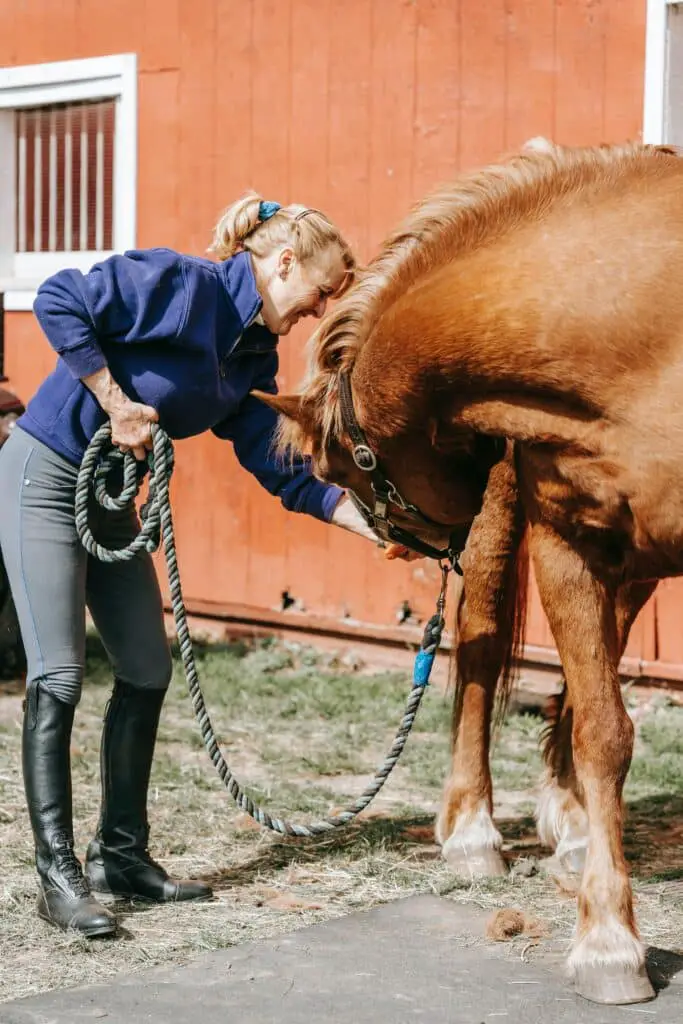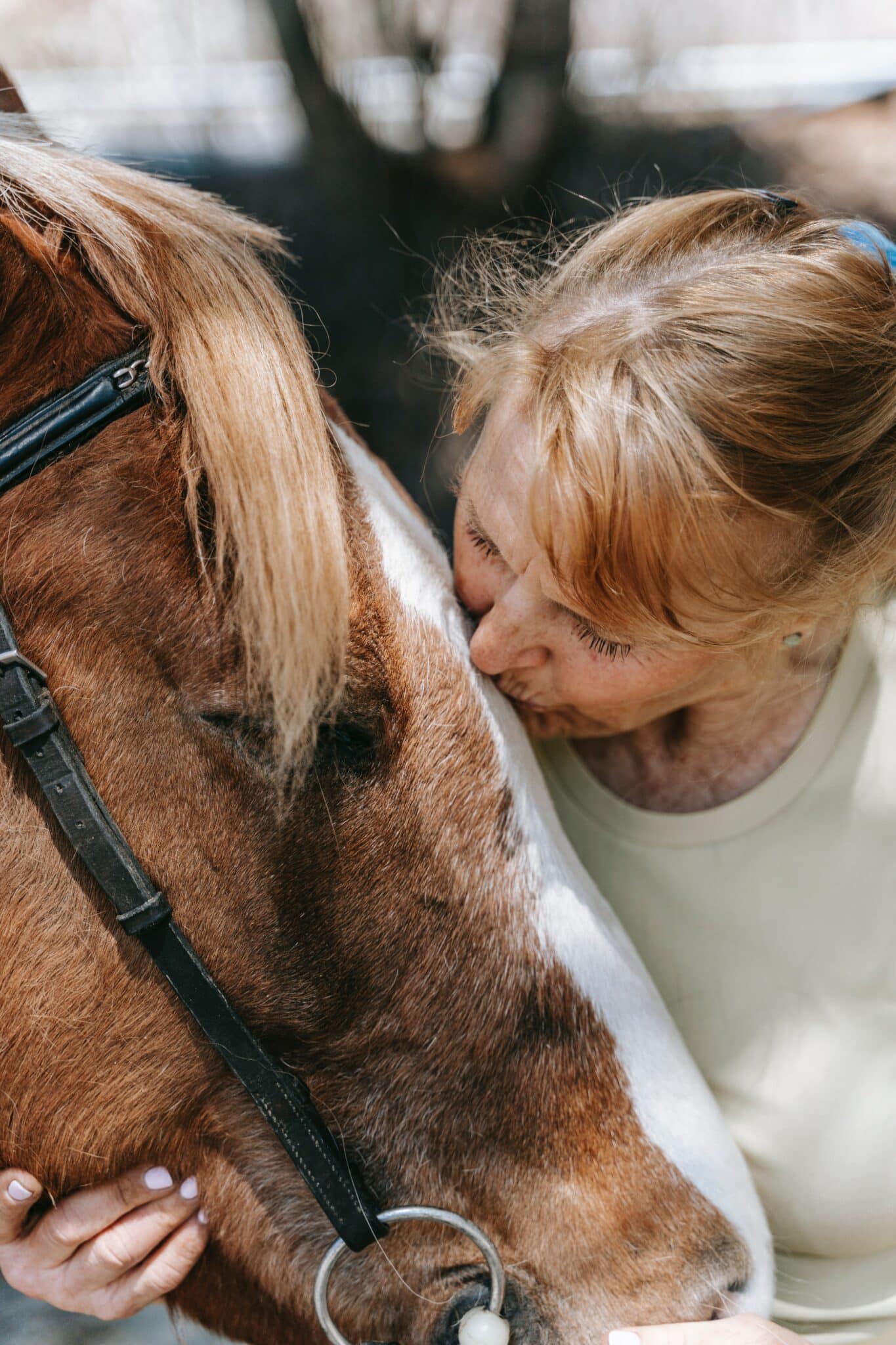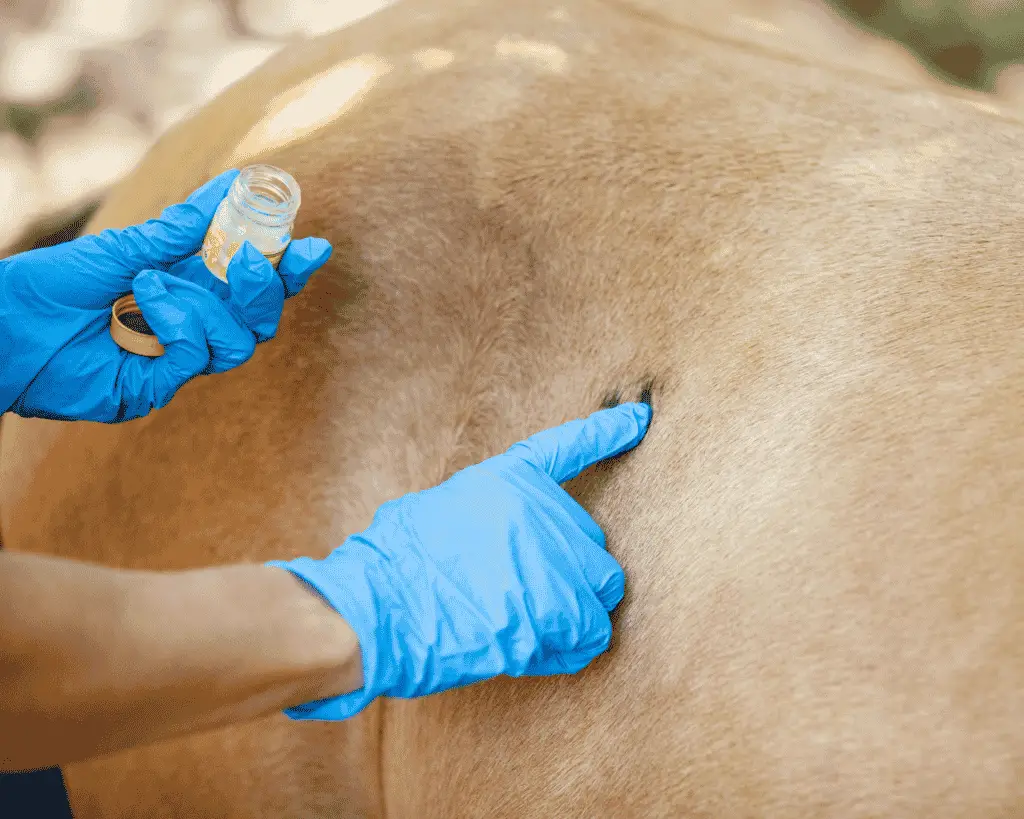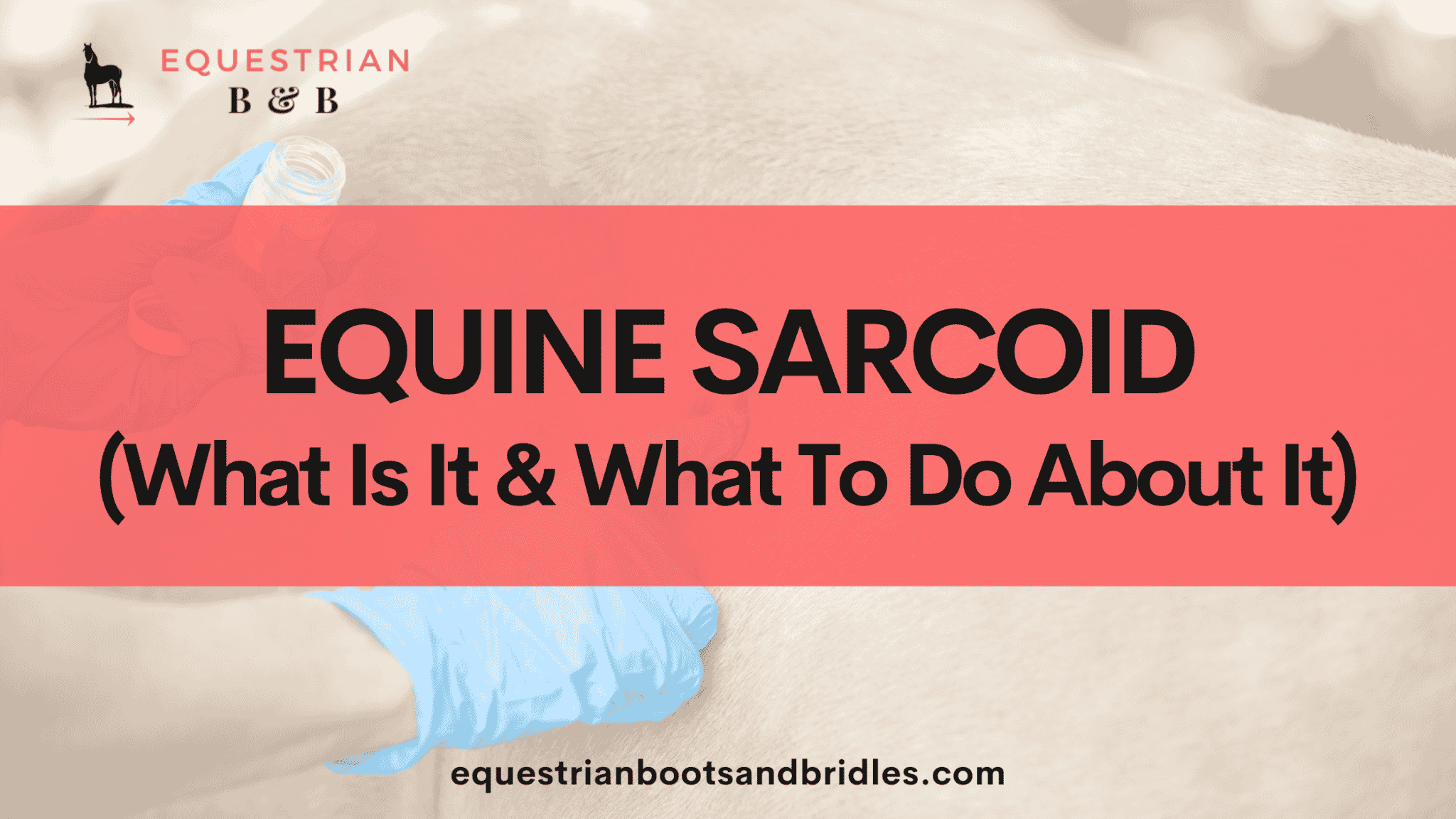An equine sarcoid is the horse version of skin cancer known as an aggressive fibroplastic neoplasm. It’s the most common type of cancer in horses and has multiple types of appearances and presentations. You might notice a lesion that doesn’t have hair growth, spot a sore that won’t heal properly, or observe a small lump that grows into a large growth seemingly overnight. It has multiple causes that include viral infection and genetics.
Sarcoids are a stand-alone form of cancer in that they are not related to any other type of cancer. The appearance of a sarcoid doesn’t mean that your horse will eventually develop other types of cancer during its lifetime.
Spotting an equine sarcoid doesn’t mean you should panic, although you do want to get it treated quickly. Instead, sarcoid on horses is more of a nuisance that mildly affects their overall quality of life in most cases. A sarcoid can be irritating and painful, but it can also be a minor nuisance that never bothers your horse. They form in certain areas of the body and are also likely to form on top of scars.
Equine medical science hasn’t been able to find a definitive cause for sarcoids, but the current theory is that it’s transmitted by flies carrying bovine papillomavirus. Flies transmit the virus when they land on a horse and attack an open sore or bite. The virus then starts replicating once it’s made a home in the horse. Not all horses will develop sarcoids, while others will develop multiple tumors and lesions throughout their lives.
The bad news about horses who have sarcoids is that they will always be prone to developing lesions and bumps throughout their life. The good news is that sarcoids are not related to other cancers, and a horse that has sarcoids can live a long life.
Advances in sarcoid treatment have produced results that slow down and even eliminate the recurrence of sarcoids, but to date, there is no medication that can prevent their appearance. What is certain is that all horses have a different response to treatment with some horses achieving permanent cessation of tumor development while others have no response at all.
Read on to learn more about equine sarcoid, what to expect from its appearance, how to treat it, and how you and your horse can live with the condition.
As always, this information is for educational purposes only and you should always consult with your veterinarian when it comes to your horse’s health.
Understanding Equine Sarcoid
A sarcoid is not life-threatening, but a tumor can erupt in inconvenient locations on a horse’s body and become uncomfortable or painful. They can appear anywhere on the body and are likely to re-form in areas from where they’ve been removed. Sarcoids can form as a single growth or have multiple sarcoids in a line on an afflicted area, or they can appear as lesions that look like proud flesh, also known as exuberant granulation tissue.
Equine sarcoids represent almost 40% of all skin tumors on horses and occur on all coat colors, skin types, sexes, and at all ages. It’s estimated that 2% of the global equine population is affected by equine sarcoid.
There is no one defining factor that causes a horse to develop a sarcoid, even though it was once thought that it was most common in gray horses. However, Lippizaners, a breed that is almost always gray, have been shown to resist the development of sarcoids. On the other hand, Thoroughbreds, a breed that features multiple coat colors, are more likely to develop them.
Sarcoids are considered a form of cancer, but it’s one that’s almost always benign. While no horse owner wants to see them appear on their horse, they’re not an indicator that something more serious is going on inside your horse’s body.

Why Sarcoid on Horses Happens
The main suspected cause of sarcoid on horses is bovine papillomavirus (BPV) types 1 and 2, in combination with a genetic predisposition. In terms of genetic predisposition, it’s been noted that some bloodlines are more likely to develop sarcoids than others. Breeding a pair of horses that both have sarcoids also increases the risk that their offspring will develop sarcoids.
The cause of sarcoid on horses is currently a working theory. Equine medical science has yet to prove the link, but the evidence for the link between BPV and sarcoids is strong. Transmission of BPV is thought to occur when a fly carrying the virus lands on a horse with a wound. As they bite at the wound, they inject their viral load into the horse’s bloodstream.
Other potential sources of BPV come in the form of contamination from shared tack and sharing a pasture with a stablemate that has an existing wound.
Not every horse that comes into contact with the virus will develop sarcoids, however. Research suggests that a horse has to be genetically predisposed to developing sarcoids. That means some horses will never carry the virus after exposure, or their immune systems are capable of repressing the virus and preventing it from developing into a tumor.
The Different Types of Equine Sarcoid
Sarcoids can appear anywhere on a horse’s body, but they’re most commonly found in areas where there is little to no hair or the skin is thin. They appear near the eyes, ears, the sheath, between the hind legs, chest, and neck. Tumors are also likely to form on top of scars and old injury sites.
Sarcoids often look like proud flesh or a type of tumor known as a benign fibropapilloma. When there is uncertainty, a biopsy is recommended to determine the type of tumor prior to treatment. The results of the biopsy inform the veterinarian of the condition and how best to treat the tumor.
There are six distinct types of sarcoids recognized by veterinary science. They include:
1. Verrucose
This type has a gray, warty, or scabby appearance and may contain small nodules that feel solid to the touch. Ulcerations can accompany this appearance and can cover large areas.
2. Occult
An occult sarcoid is flat, gray in color, and has no hair covering the area. It’s typically circular in shape.
3. Nodular
Multiple, solid bumps that usually cluster together in an area. They’re also prone to ulcerating and bleeding.
4. Fibroblastic
A single fleshy mass that can have a pedicle (fleshy thread) attaching to the skin or a flat, wide base where it attaches to the skin. The tumor itself is firm to the touch when squeezed.
5. Mixed
There are multiple types of tumors located in one area or across the body.
6. Malevolent
A malevolent sarcoid is the rarest type of tumor. It spreads throughout the skin and forms nodules and lesions that ulcerate and bleed.

Preventing Equine Sarcoids
Unfortunately, there are no therapies for the prevention of equine sarcoids. The method in which the virus is transmitted makes it just about impossible to prevent a horse from becoming infected. That’s not to say nothing is being done about the issue, as there is a vaccine in the works. However, it takes time to bring an effective vaccine to market.
In the meantime, researchers and veterinarians have developed effective treatments for reducing and even eliminating the recurrence of sarcoids in horses. These treatments consist of medical and pharmaceutical treatments as well as natural treatments.
Treatments for Sarcoid in Horses
It’s important to seek treatment for a sarcoid as quickly as possible. The sooner a sarcoid is caught, the easier it is to resolve it and minimize the potential for spreading. However, the virus that generates the sarcoid is aggressive in that it won’t go away easily.
There are a few options for treating equine sarcoid, and all of them have varying degrees of effectiveness. Most of the treatment options have the potential to leave behind pockets of the virus that repopulate and regenerate the tumors.
The goal of treating a sarcoid is to eliminate the tumor in its entirety, but it’s generally accepted that the tumor may regrow in time and can even spread. A horse with sarcoids may undergo multiple treatments of varying types throughout its lifespan.
The most common type of medical treatment for sarcoid tumors includes the use of an immune stimulant, ligation, chemotherapy, topical chemotherapy creams, electrochemotherapy, and/or surgical excision.
Ligation
Ligation, also known as banding, is the act of using a rubber band around the base of the tumor to cut off its blood supply. It’s used primarily on tumors that are hanging off the body by a stalk.
Surgery
Surgical excision is one of the more common methods for treating sarcoids. The veterinarian puts the horse under anesthesia to facilitate the removal of the sarcoid tumor. Removal seeks to debulk the tumor, then remove as much of the diseased tissue as possible and leave behind a clean wound with healthy tissue. Once the veterinarian is satisfied with the removal, they suture the area and let the healing process begin.
The major drawback to surgical excision is the fact that it’s not always possible to get all of the tissue containing the virus removed. It’s not unusual for a tumor to return to the surgical site due to the fact that the virus begins replicating itself once again and starts growing a new tumor.
Immunotherapy
Immunotherapy uses an immune system boosting agent injected directly into the tumor. The treatment was created using existing technology that inserted specific BPV genes into an influenza virus that invades the cells of sarcoids. The use of immunotherapy to boost a horse’s immune system has been around for some time, but applying it to equine sarcoids is recent.
The good news about immunotherapy is the fact that it attacks all sarcoids on a horse’s body. The tumor used for the injection site is the conduit for the treatment and disappears at the same rate as other tumors that are located on the horse. The end result is that all tumors disappear instead of just one. Visible tumor reduction is seen about two weeks after the initial injection, and all tumors shrink at about the same rate.
However, the bad news about immunotherapy is the fact it doesn’t work on all horses, and it’s not understood why. What is known is that some of the non-responsive horses had severe cases of sarcoids for a long period of time and the other set of horses had unsuccessful treatment in their past.
Chemotherapy and Electrochemotherapy
Chemotherapy and electrochemotherapy are two common treatments currently in use. Cisplatin, a chemotherapy drug, is placed on the surface of the tumor and left there to prevent the cells from reproducing and make them die off.
Electrochemotherapy consists of the use of a tool that emits electrical pulses throughout the entire sarcoid. The electrical pulse weakens the cell walls of the virus and makes it more susceptible to chemotherapy medication.

How to Treat Sarcoid on Horses Naturally
There are a number of options for treating sarcoids on horses through natural means of treatment. They include using the horse’s own immune system to create a defensive response, cryotherapy, and topical treatment with extracts of bloodroot.
Cryotherapy
Cryotherapy consists of using liquid nitrogen to kill off the sarcoid in much the same way it’s used to kill a wart. A probe filled with liquid nitrogen is inserted into the tumor, then left there for a short period of time to allow the nitrogen the opportunity to kill off the tumor cells. The tumor eventually dies and falls off.
There are benefits to cryotherapy, including the fact it can be done as a farm call. Cryotherapy also leaves more healthy tissue behind than surgery does and is more effective at killing off remaining pockets of BPV. Unfortunately, cryotherapy only treats the problem and won’t provide a long-term cure. Tumors are more likely to reoccur in the place they were removed from, and treatment can require multiple visits from the vet.
Autologous Vaccination
An autologous vaccination is the oldest known form of vaccination and has been used with great success in the treatment of equine sarcoids. On the surface, autologous vaccination sounds primitive and a little gross, but it’s a proven technique that works well when it comes to resolving sarcoids.
The vaccination process consists of removing an existing sarcoid, dissecting the tumor, and preparing it for reinsertion, then placing it into the horse along its crest line. The horse is returned to its normal life while its immune system uses the information from the reinserted pieces to mount a defense against BPV.
It takes months for results to appear, and immunotherapy is often employed along with autologous vaccination to improve outcomes.
Topical Creams
The most common natural treatment for equine sarcoid is a topical cream containing an extract from the bloodroot plant. Bloodroot is part of the poppy family of plants and has been found to be effective at removing sarcoids. However, it does burn and can make a horse avoid repeated applications.
There are creams available that are effective at removal and won’t create a burning sensation. However, topical creams only address the removal of the tumor and won’t stop them from recurring.
In Conclusion
There’s no denying the fact that equine sarcoid is tough to treat, much less resolve permanently. A horse may have a handful of lesions and tumors over its lifetime, or it may be a recurring issue that never fully goes away. It’s difficult to know, much less predict, how and where your horse will develop a sarcoid.
However, equine medical science has equine sarcoid under constant study and research, and new therapies are always emerging. In the meantime, you can help your horse by calling the vet for an exam the moment you suspect the appearance of a sarcoid. The quicker you get treatment, the better the outcome in the short and long term.

